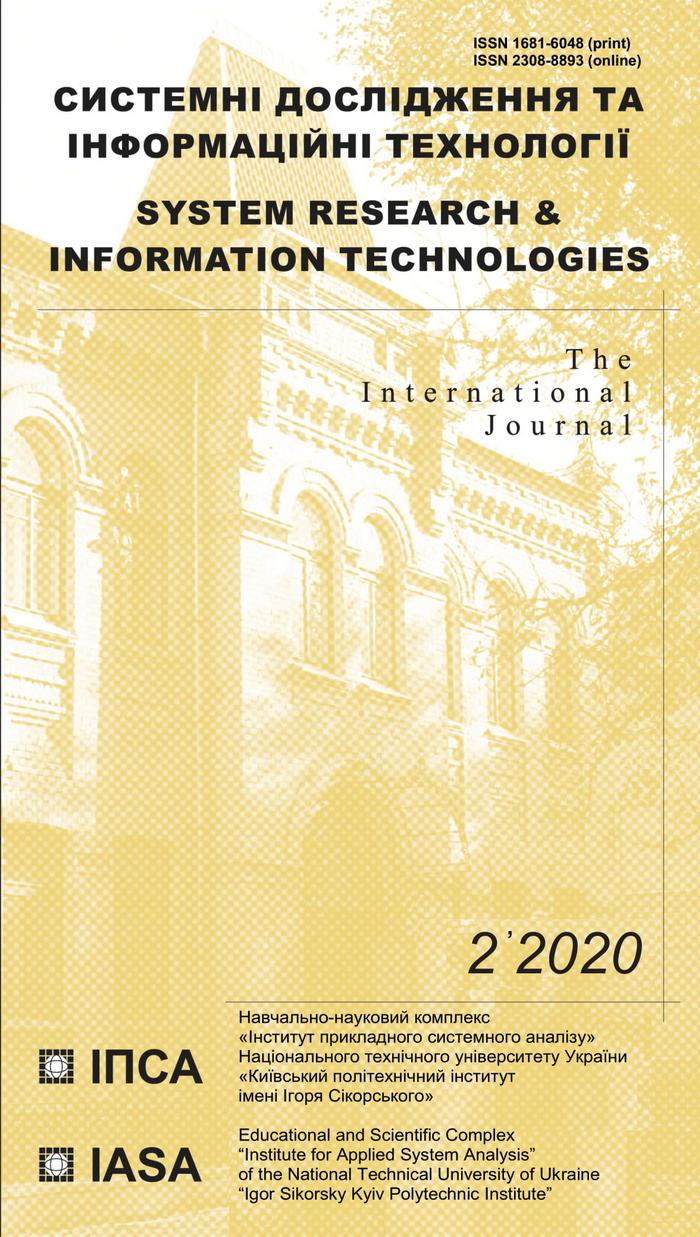Mathematical modeling of the stress state in an orthotropic electroelastic space with an arbitrary oriented spheroidal cavity under internal pressure
DOI:
https://doi.org/10.20535/SRIT.2308-8893.2020.2.10Keywords:
mathematical modeling, orthotropic piezoelectric material, coupled system of equations of electroelasticity, spheroidal cavity, arbitrary orientation, inner pressure, stress stateAbstract
The stress state of an orthotropic electro-elastic space with an arbitrary oriented spheroidal cavity under internal pressure is investigated based on mathematical modeling. The problem's solution is obtained by using the Eshelby equivalent method, generalized to the case of orthotropic piezoelectric material, and the integral representation of the Green function for an anisotropic electroelastic space. Testing the algorithm for solving the problem on a special case (for a transversely isotropic electrical-elastic material with a spheroidal cavity) confirms its effectiveness. The numerical studies of the stress state in an orthotropic electroelastic material with a cavity under internal pressure were carried out, characteristic patterns of stress distribution were revealed.References
F. Dinzart and H. Sabar, “Electroelastic ellipsoidal inclusion with imperfect interface and its application to piezoelectric composite materials”, Int. J. Solids and Struct., vol. 136–137, pp. 241–249, 2018.
C. Hwu, W.-R. Chen, and T.-H. Lo, “Green’s function of anisotropic elastic solids with piezoelectric or magneto-electro-elastic inclusions”, Int. J. Fracture, vol. 215, no. 1–2, pp. 91–103, 2019.
G. Iovane and A. V. Nasedkin, “Numerical modelling of two-phase piezocomposites with interface mechanical anisotropic effects”, Advanced Structured Materials, vol. 103, pp. 293–304, 2019.
S.A. Kaloerov and E.S. Glushankov, “Determining the Thermo-Electro-Magneto-Elastic State of Multiply Connected Piecewise-Homogeneous Piezoelectric Plates”, Journal of Applied Mechanics and Technical Physics, vol. 59, no. 6, pp. 1036–1048, 2018.
H.B. Li, Y.D. Li, and X. Wang, “Effects of inclusion on the creep rate of piezoelectric films”, Mechanics of Advanced Materials and Structures, vol. 26, no. 4, pp. 300–306, 2019.
V.V. Loboda, A.G. Kryvoruchko, and A.Y. Sheveleva, “Electrically plane and mechanically antiplane problem for an inclusion with stepwise rigidity between piezoelectric materials”, Advanced Structured Materials, vol. 94, pp. 463–481, 2019.
G. Martínez-Ayuso, M.I. Friswell, H. Khodaparast Haddad, J.I. Roscow, and C.R. Bowen, “Electric field distribution in porous piezoelectric materials during polarization”, Acta Materialia, vol. 173, pp. 332–341, 2019.
X. Peng, M. Yu, and Y. Yang, “Interaction between a generalized screw dislocation in the matrix and an inhomogeneity containing an elliptic hole in piezoelectric–piezomagnetic composite materials”, Mathematics and Mechanics of Solids, vol. 24, no. 10, pp. 3080–3091, 2019.
J. Shi and A.H. Akbarzadeh, “Architected cellular piezoelectric metamaterials: Thermo-electro-mechanical properties”, Acta Materialia, vol. 163, pp. 91–121, 2019.
Y. Solyaev and S. Lurie, “Numerical predictions for the effective size-dependent properties of piezoelectric composites with spherical inclusions”, Composite Structures, vol. 202, pp. 1099–1108, 2018.
Yu.N. Podil’chuk, “Exact Analytical Solutions of Static Electroelastic and Thermoelectroelastic Problems for a Transversely Isotropic Body in Curvilinear Coordinate Systems”, Int. Appl. Mech., vol. 39, no. 2, pp. 132 – 170, 2003.
L. Dai, W. Guo, and X. Wang, “Stress concentration at an elliptic hole in transversely isotropic piezoelectric solids”, Int. J. Solids and Struct., vol. 43, no. 6, pp. 1818–1831, 2006.
M.L. Dunn and M. Taya, “Electroelastic Field Concentrations In and Around Inhomogeneities In Piezoelectric Solids”, J. Appl. Mech.,vol. 61, no. 4, pp. 474– 475, 1994.
Y. Mikata, “Explicit determination of piezoelectric Eshelby tensors for a spheroidal inclusion”, Int. J. Solids and Struct., vol. 38, no. 40–41, pp. 7045–7063, 2001.
Yu.N. Podil’chuk and I.G. Myasoedova, “Stress State of a Transversely Isotropic Piezoceramic Body with Spheroidal Cavity”, Int. Appl. Mech., vol. 40, no. 11, pp. 1269–1280, 2004.
C.R. Chiang and G.J. Weng, “The nature of stress and electric-displacement concentrations around a strongly oblate cavity in a transversely isotropic piezoelectric material”, Int. J. Fract., vol. 134, no. 3–4, pp. 319–337, 2005.
V.T. Grinchenko, A.F. Ulitko, and N.A. Shulga, “Electroelasticity”, Mechanics of coupled fields in structural elements: in 6 volumes., vol. 1. Kyiv: Naukova Dumka, 1989.
M.O. Shulga and V.L. Karlash, Resonant electromechanical vibrations of plates. Kyiv: Naukova Dumka, 2008.
V.S. Kirilyuk, O.I. Levchuk, and H. Altenbach, “Calculation of Stress Intensity Factors for an Arbitrary Oriented Penny-shaped Crack Under Inner Pressure in an Orthotropic Electroelastic Material”, Advanced Structured Materials, vol. 108, pp. 211–222, 2019.
V.S. Kirilyuk and O.I. Levchuk, “Stress State of an Orthotropic Piezoelectric Material with an Elliptic Crack”, Int. Appl. Mech., vol. 53, no. 3, pp. 305–312, 2017.
Y.Y. Zhou, W.Q. Chen, and C.F. Lu, “Semi-analytical solution for orthotropic piezoelectric laminates in cylindrical bending with interfacial imperfections”, Composite Structures, vol. 92, no. 4, pp. 1009–1018, 2010.
V.S. Kirilyuk and O.I. Levchuk, “Stress State of an Orthotropic Piezoelectric Body with a Triaxial Ellipsoidal Inclusion Subject to Tension”, Int. Appl. Mech., vol. 55, no. 3, pp. 305–310, 2019.
S.G. Lekhnitskii, Theory of Elasticity of an Anisotropic Body. Moscow: Mir, 1981.

